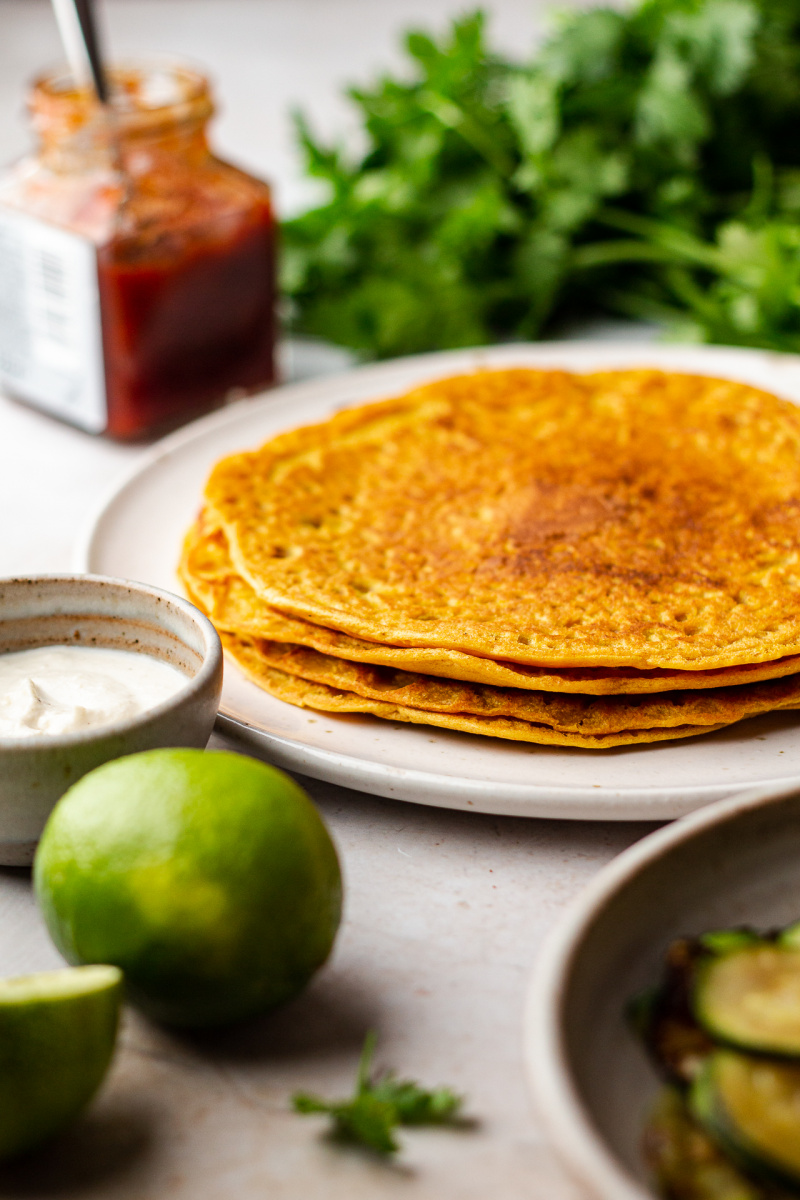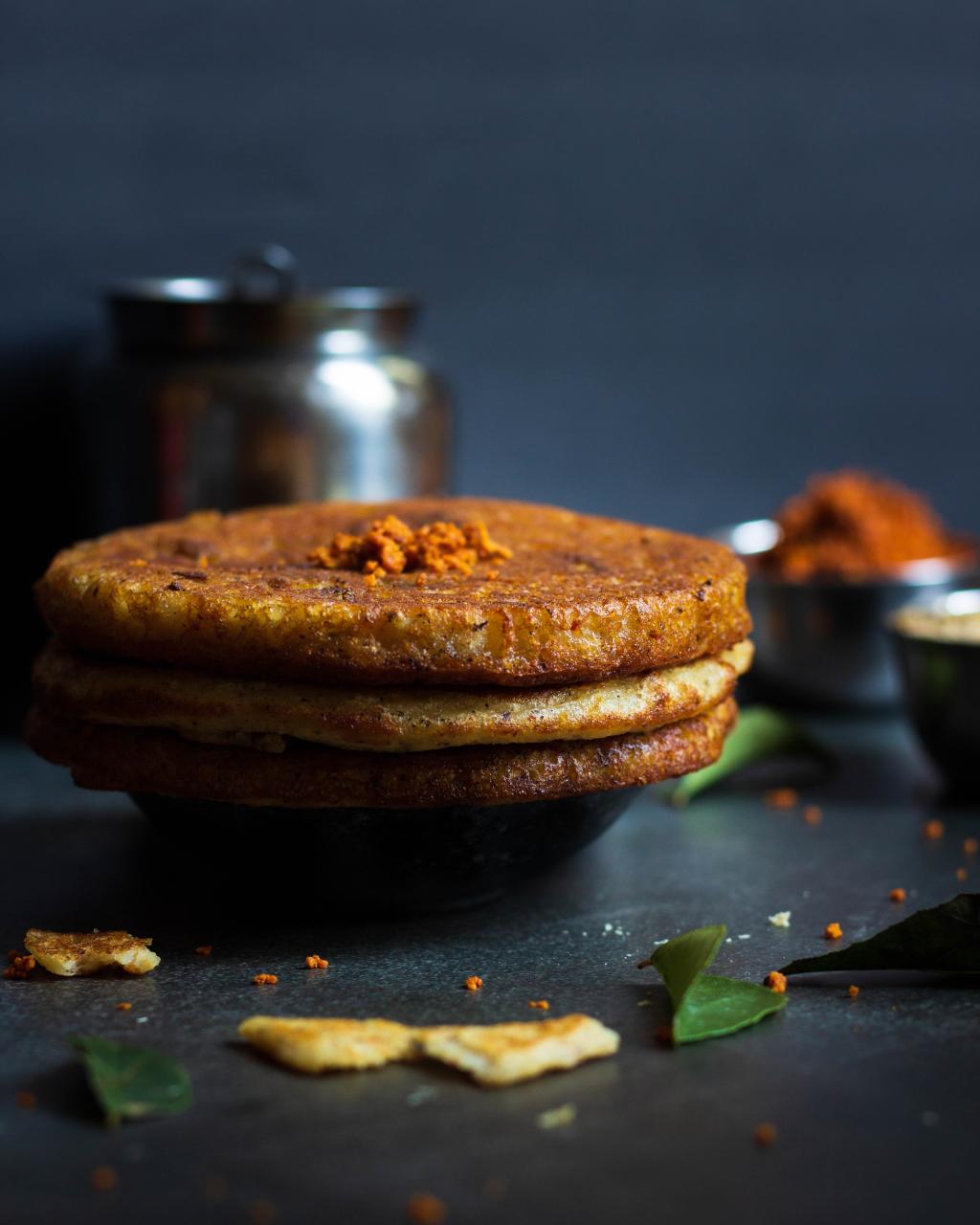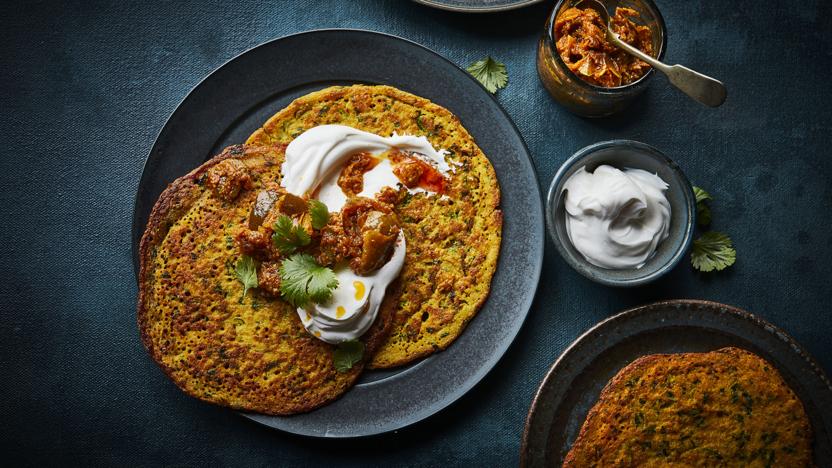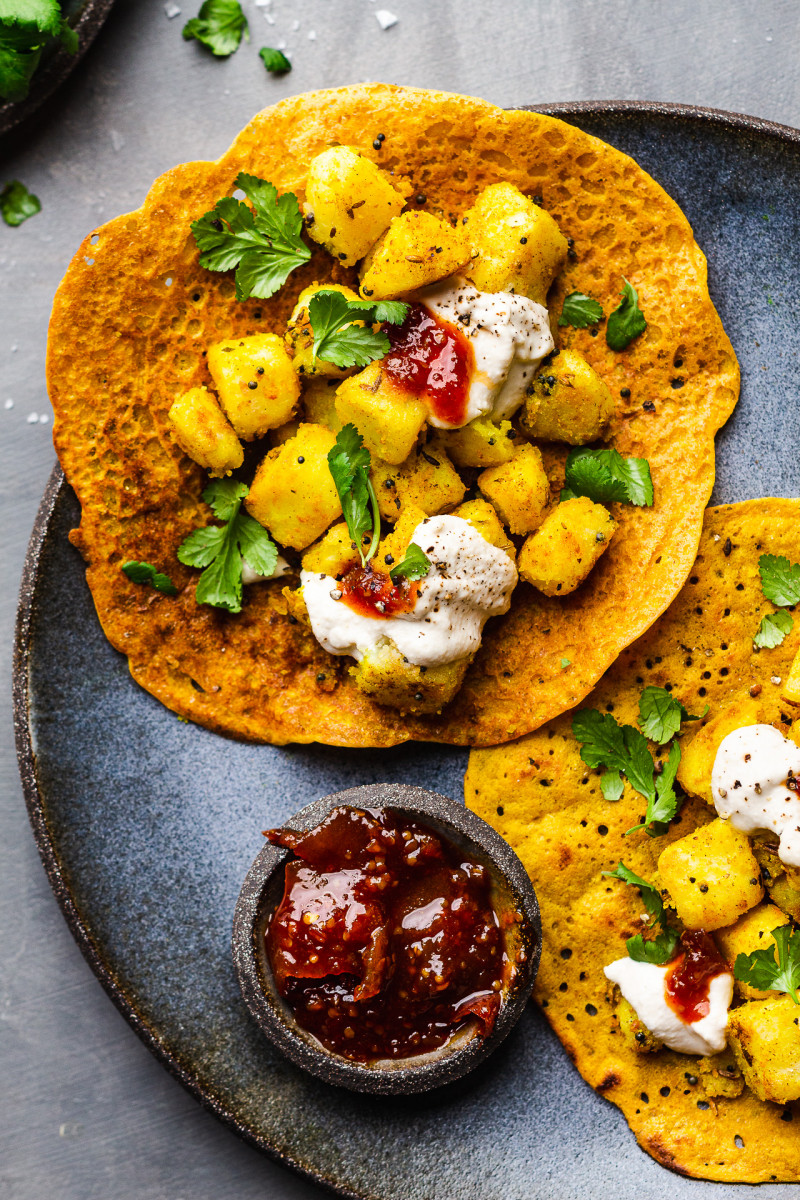Adai is a type of pancake from the South Indian cuisine that is made from a mixture of lentils and rice. This dish is a staple in Tamil Nadu and is known for its nutritious value, savory flavors, and versatility. The primary ingredients typically include a mix of lentils such as urad dal (black gram), moong dal (green gram), toor dal (pigeon pea), and chana dal (Bengal gram), which are soaked along with rice for several hours or overnight. The lentils and rice are then ground into a batter, often with the addition of spices and chillies, and sometimes include onions or other vegetables for added texture and flavor.
These mixed lentil pancakes, known for their richness in protein, provide a balanced meal with complex carbohydrates coming from the rice and dietary fibers. Adai can be customized to taste preferences and dietary needs. It’s commonly served with accompaniments like coconut chutney, jaggery, or avial (a thick mixed vegetable stew), balancing the flavors and enhancing the overall meal.
Adai MixedLentil Pancakes Recipe


Adai MixedLentil Pancakes
Equipment
- 1 large bowl
Ingredients
- 2 dried Guntur chiles
- 1/2 cup raw rice sona masoori or ponni variety, rinsed at least four times with cool water,
- drained well
- 2 tablespoons husked whole black lentils rinsed at least four times with cool water, drained well
- 2 tablespoons Bengal gram rinsed at least four times with cool water, drained well
- 2 tablespoons split yellow mung beans rinsed at least four times with cool water, drained well
- 2 tablespoons split pigeon peas rinsed at least four times with cool water, drained well
- 1/2 to 3/4 cup water
- 11/2 teaspoons salt
- 1/4 cup finely chopped onion
- 2 tablespoons finely chopped fresh cilantro
- 10 teaspoons vegetable or corn oil divided
- Avial for serving
Instructions
- In a large bowl, combine the Guntur chiles and enough cold water to cover by 2 to 3 inches. Let soak at room temperature for 6 to 8 hours. Drain.
- In a blender, combine the rice, black lentils, Bengal gram, split lentils, pigeon peas, and the soaked chiles. Pulse the blender a few times to grind.
- With the blender running, slowly pour in 1⁄2 cup of water and blend until the adai batter is thick and a bit coarse, but still pourable. Use up to 1⁄4 cup more water, as needed. Transfer the batter to a large bowl. Stir in the salt, onion, and cilantro.
- Heat a griddle over medium heat.
- Reduce the heat to low and pour a ladleful of batter onto the griddle. Using the back of the ladle, spread the batter around the griddle starting from the middle. Drizzle 1 teaspoon of oil around the edges of the adai. Increase the heat to medium and cook for 60 to 90 seconds. Using a spatula, loosen the edges of the adai and carefully flip it. Cook for 30 to 40 seconds more. Transfer the adai to a plate. Repeat with the remaining batter and oil. Serve with avial, chutney, or powdered jaggery and ghee.
Notes
Cooking Tips about Adai MixedLentil Pancakes

- Soaking Time: Soak the lentils and rice for at least 4-6 hours, or overnight if possible, as this helps soften them and makes the grinding process easier. This also ensures that the final batter ferments slightly, leading to a better texture.
- Grinding Consistency: Unlike dosa batter, which is very fine and smooth, adai batter should be slightly coarse to maintain its characteristic texture. However, avoid making it too gritty, as the pancakes may become too hard.
- Fermentation: Adai batter requires less fermentation time compared to dosa batter. A couple of hours of fermentation is sufficient to enhance flavor and digestibility.
- Adding Vegetables: Incorporate finely chopped onions, grated carrots, or other vegetables into the batter to increase the nutritional value and add more flavors to the adai.
- Spices and Herbs: Customize the basic batter by adding different spices such as cumin, black pepper, or even finely chopped ginger. Fresh herbs such as coriander leaves can also be mixed in for added taste.
- Thickness of Pancake: Adai pancakes are typically thicker than dosas. Pour a ladleful of batter onto the hot pan and gently spread it to the desired thickness. However, they should not be too thick, as they may not cook evenly.
- Cooking on Medium Heat: Cook the adai on medium heat to ensure that it’s evenly cooked and gets a nice golden-brown color. Since it’s thicker, it takes a little longer to cook than a typical dosa.
- No-flip Cooking: It’s not always necessary to flip adai pancakes. You can cook them covered on one side on low heat until done. However, if you prefer a crispier finish, you can flip and cook on both sides.
- Resting the Batter: If the batter is too thick after grinding, it can thicken further on resting. If necessary, adjust the consistency of the batter with a little water before cooking to ensure it spreads easily on the pan.
- Use of Oil: Adai pancakes often require a bit more oil for cooking than plain dosas, as the lentils in the mixture tend to stick to the pan. Use a well-seasoned cast iron or non-stick pan to minimize sticking.
Serving suggestions about Adai MixedLentil Pancakes

- Chutneys and Dips: Adai pairs well with an array of chutneys which can enrich the flavor profile. Coconut chutney, made with fresh grated coconut, green chilies, and tempered with mustard seeds and curry leaves, is classic. Tomato, mint, or coriander chutney all offer tangy and fresh counterpoints to the hearty Adai.
- Sambhar: A South Indian lentil stew made with pigeon peas (toor dal), mixed vegetables, tamarind, and a special blend of spices known as sambhar masala. This combination adds a savory and slightly tangy dimension to the meal, while boosting the protein content further.
- Yogurt or Raita: Serving these pancakes with a side of plain yogurt or raita (yogurt mixed with cucumber, spices, and herbs) can add a cooling contrast to the spices in Adai. This also enhances the meal’s calcium and probiotic content.
- Pickles: A small serving of Indian pickles (achar) can provide a burst of intense flavor due to their spiciness and tang. This should be served in moderation due to the high sodium content in pickles.
- Salads: A fresh salad with crisp vegetables, sprouts, and a lemony dressing can provide a refreshing and fibrous side that balances the Adai’s richness.
- Avial: A coconut-based vegetable curry containing a variety of vegetables and subtly flavored with coconut oil and curry leaves. Avial complements the savory Adai with its sweet and mellow flavors.
- Protein Toppings: For those seeking extra protein, one can add toppings like paneer, tofu, or scrambled eggs to the Adai. These can be seasoned to match the flavors of the pancake.
Top 5 FAQs about Adai MixedLentil Pancakes

- What are the ingredients needed to make Adai mixed lentil pancakes? Adai pancakes typically require a range of lentils such as urad dal, chana dal, toor dal, and moong dal, in addition to rice. The proportions may vary, and sometimes fenugreek seeds are added for flavor and digestive benefits. Spices such as asafoetida, red chilies, and curry leaves are also common, enhancing the taste profile. Water is used to soak the ingredients and to grind them into a batter, which is then seasoned with salt.
- How are Adai mixed lentil pancakes prepared? The lentils and rice are soaked in water for several hours, after which they are drained and ground to create a coarse batter. Spices and salt are then mixed into this batter. The batter is typically thicker than that of dosa, a similar South Indian dish. To cook the pancakes, a ladleful of batter is poured onto a hot pan or griddle and spread into a thick circle. It is cooked on both sides until crisp and golden brown. Ghee or oil may be used to fry the Adai, which can influence the flavor and caloric content.
- What are the health benefits of eating Adai mixed lentil pancakes? Adai is rich in protein due to the various lentils included in the recipe, which makes it a valuable dish for vegetarians and vegans seeking to increase their protein intake. The dish is also high in dietary fiber, which is beneficial for digestion, and includes a range of vitamins and minerals from the lentils and rice. Furthermore, it has a low glycemic index, which can be good for blood sugar management.
- Are Adai mixed lentil pancakes suitable for those with dietary restrictions? Adai can be suitable for various dietary needs. It is inherently gluten-free, as it does not contain wheat. With appropriate ingredient modifications such as using oil instead of ghee, Adai can be made vegan. However, those with specific dietary restrictions related to legumes should avoid Adai since it is lentil-based.
- Can Adai mixed lentil pancakes be made ahead of time? Yes, the Adai batter can be prepared in advance and stored in the refrigerator for several days. This convenience allows for quick meal preparation during the week. Additionally, cooked Adai pancakes can be stored in the refrigerator and reheated, although the texture may vary from fresh pancakes.
Adai is a traditional South Indian dish, typically served as a savory pancake that is made from a mixture of lentils and rice. The lentils used in Adai can include a combination such as urad dal, chana dal, and toor dal, among others. This mix provides a rich source of protein and fiber, as well as essential vitamins and minerals, which can contribute to a balanced diet. Because it is fermented, Adai batter also has the added benefit of being easier to digest and may have improved nutrient availability.

Leave a Reply